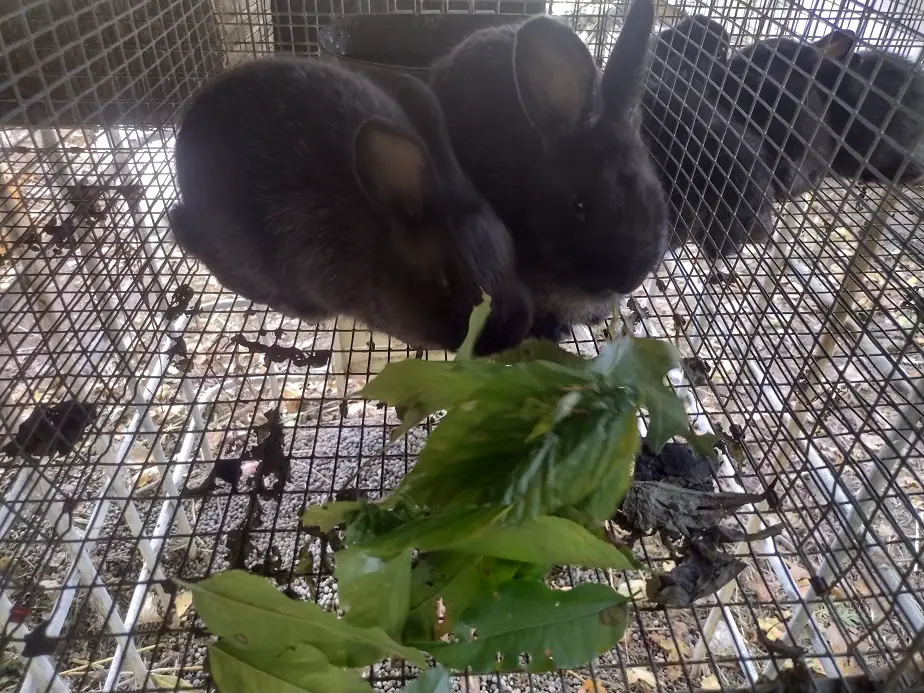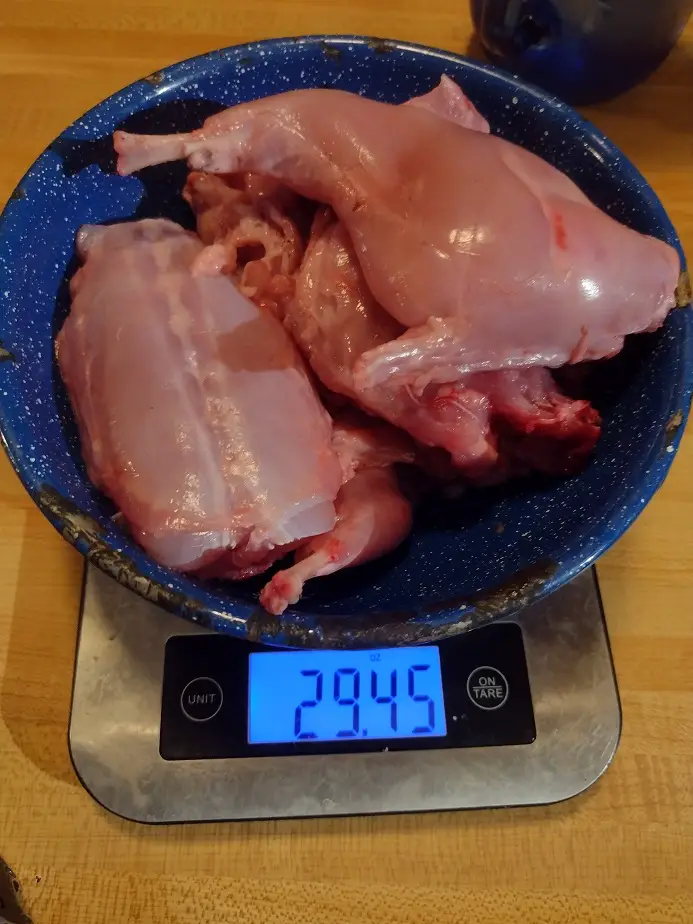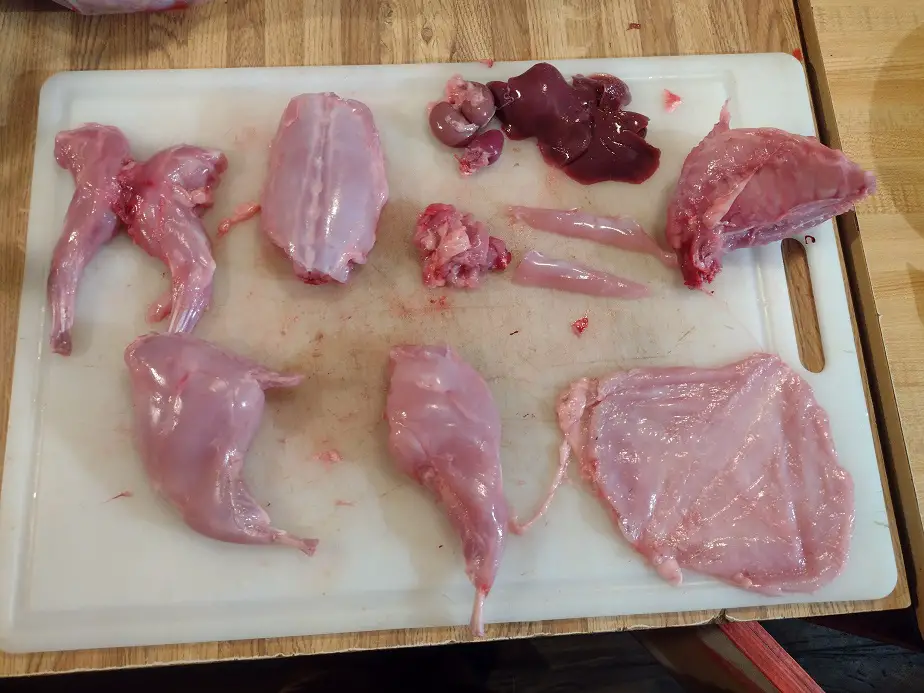In the last 5 years, I have butchered more rabbits than I can count. We fill half a freezer every year.
Commercial meat rabbits produce a 2.5-pound carcass, but home-raised rabbits can vary from 1 and 3 pounds of meat per animal. Grass-fed rabbits will butcher out smaller than rabbits fed a high-protein diet, and rabbits raised outdoors usually grow a little slower due to fluctuating weather.
Different breeds and different raising systems produce vastly different results. Here’s what I’ve seen from 25 years around rabbits.
Meat Rabbit Yield by Breed
This list is based on my personal experience. There will be variance between different stock of the same breed. The numbers are best-case scenarios.
- Holland Lop– Live weight, 2 pounds at 10 weeks, 1 pound carcass
- Florida White– Live weight, 2 pounds at 10 weeks. 1-pound carcass
- Rex– live weight, 4 pounds at 10 weeks. 2-pound carcass
- Californian– live weight, 4 pounds at 10 weeks. 2-pound carcass
- Silver Fox– Live weight, 4.5 pounds at 10 weeks. 2.5-pound carcass
- Satin– Live weight, 4.5 pounds at 10 weeks. 2.5-pound carcass
- New Zeeland– Live weight, 5 pounds at 10 weeks. 3-pound carcass
- Giant Chinchilla– Live weight, 6 pounds at 10 weeks. 3.5-pound carcass
So, that’s a generic overview of top-performing animals raised in good systems. In general, you can expect a rabbit to grow to about half of its adult weight by 12 weeks old. Breeds with larger bone structures tend to take a bit longer.
In a slightly less “perfect” system where things are less tightly controlled, you can expect 10 to 25 percent lower carcass weight at 10 weeks. Only the best tend to hit these marks. I usually come pretty close, but may need another 2 weeks to hit the weights listed above. That’s alright.
Good meat rabbits will yield a carcass weighing half the animal’s live weight before butcher. That’s a 50% retained weight. Top-preforming commercial breeds can have a retained weight of 60 to 65 Percent.
Honestly, that’s a hard mark to hit and hasn’t really been worth it to me to reach it. I currently raise a commercial breed rabbit, the Silver Fox, and expect a 50 percent retained weight. I just butchered two today and they were a hair over 50 percent retained weight.

5 Reasons Why Rabbits Don’t Gain Well
Too much exposure to the elements is a major cause of meat rabbits gaining weight poorly. Rabbits are timid animals that like to hide from things. Rain, wind, temperature swings; these things all stress rabbits. Stress is what messes with animals.
A stressed animal gets sick more, doesn’t grow well, and doesn’t have healthy behaviors. In west Michigan, we get a lot of wind and cold rain. Autumn-reared bunnies tend to gain poorly for us. It’s the stormy season and that messes with the growth of animals, rabbits in particular.
Our rabbits are outside with a makeshift rain cover. If they were in a barn or shed, they wouldn’t be bothered as much by the nasty weather. Basically, they aren’t as happy and just don’t eat as much. Our rabbits are kept behind the house, out of the wind which helps.
I’m in the middle of putting up a covered enclosure to house all the rabbit cages. Hopefully, it will be finished soon.
Too little sunlight messes with rabbits, even though they prefer to hide from it most of the time. Rabbits love dark places to hop under, but rabbits need some natural sunlight to do well. Raising them in a barn or shed without decent windows will negatively impact their growth.
It also reduces litter size, increases the mortality rate, and can cause rabbits to not breed at all. There is no adequate substitute for natural sunlight. Rabbits need decent amounts of sunlight to regulate hormone production and to function properly.
Not enough space causes severely undersized bunnies. I’ve seen this firsthand. We had a problem with cages and had to house two and three growing bunnies in cages meant for just one. The result was rabbits that butchered out almost 30 percent underweight. That’s a sign of severe stress.
I noticed the bunnies were much more timid, hiding in the far corner of the cage. They didn’t eat or drink as much and just didn’t grow well. Lesson learned, have an extra cage ready to go.
Poor quality feed is the largest single reason for under-sized rabbits that we’ve seen. While trying out a grass-fed system, I found butcher-age rabbits to be under-sized by about 50 percent. The live weight ranged from 1.7 to 2.3 pounds when it usually was 4.4 to 5 pounds.
That type of grass, as I went on to learn, has less than half the protein the rabbits should have had. Most grasses are pretty darn low in protein. It works if it’s what you got, but it doesn’t grow big rabbits. I’m not saying you need to use the most expensive feed out there. We feed the cheapest pellets we can get.
My rabbits, when not eating fresh greens, get a locally made off-brand rabbit pellet with 16 percent protein. It’s a bit low in calories for them at times. If they are having really big litters or it’s very cold, I’ll give them some shelled corn or whole oats to up the energy a bit.
We do feed out rabbits on mostly fresh greens all summer long, and have figured out how to make it work somewhat decently. They are superbly healthy but grow have trouble getting enough protein if I’m not smart about it. I wrote an article about feeding rabbits this way. Here’s a link to it.
Parasites will severely impact the weight gain of rabbits. This is mostly a concern when raising rabbits in a colony-type setting, or if you have constant issues with flies. This is why I don’t raise rabbits on the ground. If I did, I’d have to move them around constantly to clean areas to prevent parasite infestations.
Even the common ear mite will cause rabbits to gain poorly. They stress the animals out, making them feel sick. Sick animals or animals that feel sick don’t eat. Animals that don’t eat will be thin. If you do suspect parasites, get you some wormer that’s specifically for rabbits and use it according to the lable.
Ear mites, if not too bad, can be treated with olive oil and tea tree oil. If it’s bad or persistent, just buy some ear mite medication. You can always call your local vet to ask for advice on what to look for and how to treat your animals.

How to Maximize the Yield on a Rabbit
Improve a rabbit’s gains by ensuring that it’s getting at least 16 percent protein in its feed and that it’s getting enough calories overall. It’s simple if you are buying rabbit pellets, but if feeding hay and/or fresh fodder, it takes some time to get it right.
You can tell it’s not right pretty easily, the bunnies butchered way under the listed weights at the top of the page. Protein is the single largest growth limiting factor in rabbit feed. Don’t worry about the types of protein for the most part. Pretty much all protein-rich green plants have what rabbits need for protein.
A few of the more protein-rich feeds you can get your hands on are clovers, alfalfa, comfrey, and many types of tree leaves. I have an article that covers feeding tree leaves to rabbits if you are interested. Here’s a link to it.
How to Lower the Cost of Feeding Rabbits
The cheapest way to feed meat rabbits is to feed fresh fodder, dried hay, or off-brand pellets. The most effective cheaper method is to feed them a cheap, 16 percent pellet with good ingredients. Feeding Purina, Manna Pro, or organic rabbit pellets is the most expensive way to feed rabbits.
Good rabbit pellets can contain by-products like wheat chaff or brewery grains, and grains like oats or corn, but should have alfalfa as the main ingredient. Many include a bit of soybean meal to up the protein a bit and that’s fine. Don’t worry at all about corn in rabbit feed. I have never fed a corn-free diet.
Even on a hay or grass diet, I give my rabbits a bit of corn to up the energy when needed. I have written about the “corn for rabbits concern” that may people have. I wrote an article covering my thoughts on feeding corn. It’s one of my older articles, but here’s a link to it if you’d like to read it.
Best Meat Rabbit Breed
Selecting a commercial breed rabbit from a reputable breeder will give you one among the best. Breeders that participate in rabbit shows have good knowledge of what a good specimen looks like and tend to have better animal genetics to work with. Truth is, there isn’t a “best breed” of meat rabbit.
Related posts:

